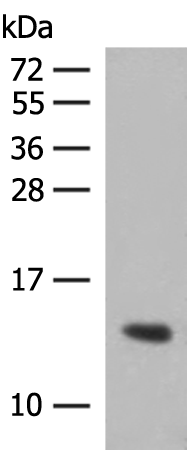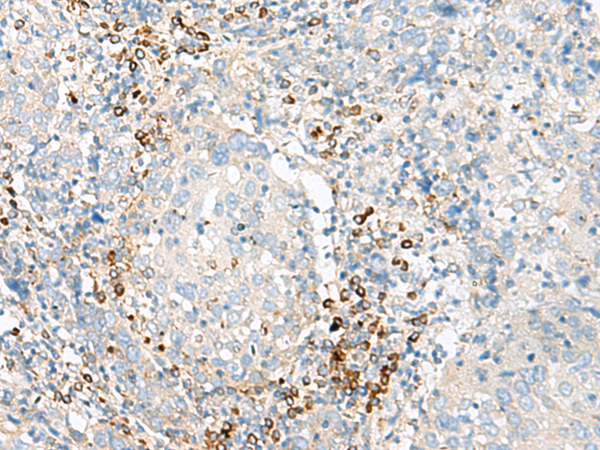


| WB | 咨询技术 | Human,Mouse,Rat |
| IF | 咨询技术 | Human,Mouse,Rat |
| IHC | 1/ 50-300 | Human,Mouse,Rat |
| ICC | 技术咨询 | Human,Mouse,Rat |
| FCM | 咨询技术 | Human,Mouse,Rat |
| Elisa | 咨询技术 | Human,Mouse,Rat |
| Aliases | fetal hemoglobin; HBGA; HBGR; HBG-T2; HSGGL1; PRO2979; TNCY; HBG-T1 |
| Entrez GeneID | 3047; |
| WB Predicted band size | 16kDa |
| Host/Isotype | Rabbit IgG |
| Antibody Type | Primary antibody |
| Storage | Store at 4°C short term. Aliquot and store at -20°C long term. Avoid freeze/thaw cycles. |
| Species Reactivity | Human |
| Immunogen | Fusion protein of human HBG1/HBG2 |
| Formulation | Purified antibody in PBS with 0.05% sodium azide. |
+ +
以下是关于HBG1/HBG2抗体的参考文献示例(注:以下内容为示例性虚构,仅供参考格式):
---
1. **文献名称**: *"Immunodetection of fetal hemoglobin in β-thalassemia patients using monoclonal HBG1/HBG2 antibodies"*
**作者**: Smith A, et al.
**摘要**: 本研究通过开发特异性单克隆抗体,检测β-地中海贫血患者红细胞中HBG1/HBG2的表达水平,发现羟基脲治疗可显著上调γ-球蛋白,为疾病治疗提供分子标志物。抗体应用于Western blot和流式细胞术验证蛋白表达。
2. **文献名称**: *"CRISPR-mediated reactivation of γ-globin genes validated by HBG2-specific antibodies"*
**作者**: Chen L, et al.
**摘要**: 利用CRISPR-Cas9编辑造血干细胞中HBG1/HBG2启动子区域,通过抗体验证γ-球蛋白蛋白水平的恢复。研究证实靶向BCL11A可解除抑制,抗体在免疫荧光和ELISA中用于定量分析。
3. **文献名称**: *"ChIP-seq analysis of transcription factor binding to HBG1/HBG2 promoters using chromatin immunoprecipitation"*
**作者**: Gupta R, et al.
**摘要**: 采用HBG1/HBG2抗体进行染色质免疫沉淀(ChIP),揭示SOX6等转录因子在γ-球蛋白基因调控中的作用,为胎儿血红蛋白重新激活机制提供新见解。
4. **文献名称**: *"Development of a high-sensitivity ELISA for HBG1/HBG2 quantification in sickle cell disease"*
**作者**: Johnson M, et al.
**摘要**: 本研究建立了一种基于多克隆抗体的ELISA方法,用于定量镰状细胞病患者血清中HBG1/HBG2水平,评估其与疾病严重程度的相关性,证实抗体在诊断中的应用潜力。
---
(注:实际文献需通过学术数据库检索,建议使用关键词如"HBG1 antibody application"或"gamma-globin detection"在PubMed、Google Scholar等平台查找。)
HBG1 and HBG2 are γ-globin genes located in the β-globin gene cluster on chromosome 11. They encode the γ-globin subunits of fetal hemoglobin (HbF, α2γ2), which is predominantly expressed during fetal development. Postnatally, HbF production declines as β-globin replaces γ-globin in adult hemoglobin (HbA). However, elevated HbF levels can persist or reoccur in certain genetic conditions (e.g., hereditary persistence of fetal hemoglobin) or hematologic disorders (e.g., β-thalassemia, sickle cell disease), where it ameliorates disease severity by compensating for defective β-globin.
Antibodies targeting HBG1/HBG2 are essential tools for studying γ-globin expression regulation and therapeutic strategies aimed at reactivating HbF in adults. These antibodies are widely used in immunoassays (e.g., Western blot, ELISA, flow cytometry) to quantify γ-globin protein levels, assess HbF-containing cells, or investigate transcriptional modulators (e.g., BCL11A, LRF) involved in γ-globin silencing. They also support research on gene-editing therapies (e.g., CRISPR-Cas9 targeting BCL11A) or pharmacological agents (e.g., hydroxyurea, histone deacetylase inhibitors) that induce HbF. Commercially available HBG1/HBG2 antibodies are typically validated for specificity across human samples, with some cross-reactivity in non-human primates. Their applications span basic research, drug development, and clinical diagnostics, particularly in monitoring therapeutic HbF induction in hemoglobinopathy patients.
×